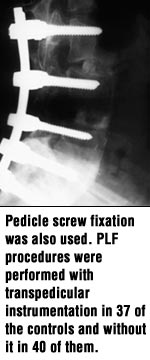Same long-term results from PLF, exercise seen for adult isthmic spondylolisthesis
Results of a prospective, randomized study suggest the benefits of fusion diminish after a decade.
 PORTO,
Portugal — Results of a Swedish long-term follow-up study of patients with
adult isthmic spondylolisthesis treated with fusion surgery showed no
significant difference in their overall results compared to patients treated
only with an exercise program.
PORTO,
Portugal — Results of a Swedish long-term follow-up study of patients with
adult isthmic spondylolisthesis treated with fusion surgery showed no
significant difference in their overall results compared to patients treated
only with an exercise program.
The only significant difference in the long-term outcomes between the two groups was their global self-assessments: 76% of patients who underwent fusion felt they were better or much better postoperatively, compared to 50% who exercised.
“The overall finding of this study was that the effects of surgery diminished at long-term follow-up,” said lead investigator Per Ekman, MD. “The reason for that may be an adjacent segment disease or a decrease in sustainable effect. This effect is unlikely, however, since the conservative group did not get worse. Results may also reflect the paradigm of regression toward the mean.”
Ekman presented the results of the prospective, randomized study at SpineWeek 2004, where it was selected as the best podium paper by the Spine Society of Europe.
All improved
![Spine Week Portugal [logo]](/~/media/images/news/print/orthopaedics-today-europe/2004/09_september/spineweek_249_100_1644.jpg) According to Ekman, who is in the department of orthopaedic surgery at
Stockholm Söder Hospital, pain was significantly affected by the
treatments used in the study, which included exercise and posterolateral fusion
(PLF) performed with or without instrumentation. “From the start of the
study to long-term [follow-up], the improvement is significant for both
groups,” Ekman said.
According to Ekman, who is in the department of orthopaedic surgery at
Stockholm Söder Hospital, pain was significantly affected by the
treatments used in the study, which included exercise and posterolateral fusion
(PLF) performed with or without instrumentation. “From the start of the
study to long-term [follow-up], the improvement is significant for both
groups,” Ekman said.
The researchers enrolled 111 adults who had isthmic spondylolisthesis that functionally disabled them for at least a year. They were randomized to undergo either a PLF procedure or an exercise regimen (57 men, 54 women; mean age 39 years old). Patients were excluded if they had prior spine surgery, psychiatric disorders or a history of drug or alcohol abuse.
Of the 77 patients randomized into the fusion group, 40 had a PLF procedure and 37 had a PLF procedure with pedicle screw fixation. Most patients had one-level procedures and some had decompressions. Those with uninstrumented PLFs were braced for six months.
The exercise group consisted of 34 patients who performed a set of prescribed exercises three times a week for six months. They then performed the exercises twice a week for six more months.
Functional disability

© B.BATES/CUSTOM MEDICAL STOCK PHOTO |
Functional disability was measured using the Oswestry disability score and the disability rating index (DRI, 0-100).
The DRI showed a similar pattern with a nonsignificant difference between the groups at long-term follow-up, he said. Patients who underwent fusion had improved DRI scores of 33 compared to 38 in those treated with exercise (P=0.01). The investigators also found no significant difference in Oswestry scores between the two groups at long-term follow-up.
Follow-up was done for nine years mean (range five to 13 years), and the follow-up rate was 90%.
Nine patients in the exercise group eventually underwent surgery.
In a corresponding study, pain and disability outcomes were similar in patients with adult isthmic spondylolisthesis who were treated with either PLF or posterolateral lumbar interbody fusion (PLIF) as part of a prospective multicenter study.
Ekman’s preliminary report, which he presented at SpineWeek 2004, contained follow-up data through two years postop for 80% of the patients operated on with PLIF. “This study shows a strikingly similar outcome with PLIF compared to PLF,” Ekman said.
“One can conclude that PLIF does not improve the outcome compared to posterolateral fusion in isthmic spondylolisthesis. One can also conclude that we found no evidence of a positive effect from interbody fusion.”
Comparison with historical controls
Investigators at four centers in Sweden sought to determine whether performing short PLIF procedures had any real advantages over performing PLF surgery for the same indications, as some researchers theorized. They performed PLIF procedures in 87 patients who were 18 to 55 years old and compared the outcomes to those of 77 historical controls from another study they conducted.
To be included, patients in both groups could have any grade of symptomatic adult isthmic spondylolisthesis occurring at any lumbar level(s) and the duration of their low back pain had to be greater than one year. Patients with prior spine surgery, psychiatric disorders or a history of drug or alcohol abuse were excluded.
Outcomes assessment was based on pain using the Visual Analog Scale, the Disability Rating Index (0-100), the Oswestry Low Back Disability Index (ODI) and the patient’s global assessment, where results were ranked as much better, better, unchanged or worse.
The PLIF surgical technique involved distraction of the disc space and implantation of carbon fiber ramps filled with autograft bone, which were wedged in place at 7° to restore lumbar lordosis. Pedicle screw fixation was also used. PLF procedures were performed with transpedicular instrumentation in 37 of the controls and without it in 40 of them.
According to the global assessment, 30% of patients who were treated with PLIF surgery were much better or better. Of those patients who underwent PLF surgery, 35% were much better or better, which was not a significant difference.
For more information:
- Ekman P, Möller H, Hedlund R. The long effect of fusion in adult isthmic spondylolisthesis – a prospective randomized study. #B48.
- Ekman P, Hedlund R, Möller H, et al. PLIF vs. posterolateral fusion in adult isthmic spondylolisthesis — a preliminary report. #B49. Both presented at SpineWeek 2004. May 31-June 5, 2004. Porto, Portugal.
